| Article ID | Journal | Published Year | Pages | File Type |
|---|---|---|---|---|
| 4064615 | Journal of Electromyography and Kinesiology | 2014 | 11 Pages |
To assess the electromyographic (EMG) activation of trunk muscle during exertions performed in one primary plane (sagittal, frontal, transverse), we previously proposed a protocol allowing minimizing out-of-plane efforts (coupled moments – CMs) with the use of a static dynamometer combined with a visual feedback system. The aims of this study were to go further by testing motor learning and reliability issues related to such a protocol. Three identical sessions were conducted, where maximal voluntary contractions and submaximal ramp contractions were performed in six different directions while standing in the dynamometer. Two feedback conditions were tested, the simple 1D-feedback in the primary plane and the full 3D-feedback in all planes simultaneously. Surface EMG signals were collected from back and abdominal muscles and EMG amplitude and CMs were computed during the ramp contractions. Providing a 3D feedback to minimize CMs did not improve EMG reliability or in other words, did not reduce the within-subject variability. Providing three assessment days had practically no effect (no learning) on CMs and EMG variables. Overall, the reliability of EMG was at best moderate. However, although this limits its use on an individual basis, it still allows within- and between-group comparisons for research applications.
